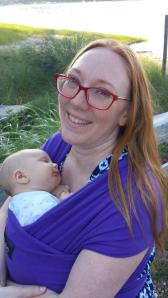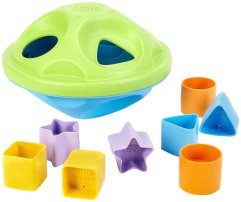For the last four weeks, Julian and I have been taking a Parent-Child class. The class is offered at a local nursery school that I toured back in September when I started looking at pre-nursery school programs for Julian. This happens to be a “Waldorf-based” program, which is a gentle, non-academic program that introduces toddlers to the world around them through creative play and cooperative activities. In our class, toddlers bake bread together (with parental guidance, of course) and then sit down together at a long table to eat the bread they have baked, drink tea, and engage with one another. It’s a truly fascinating experience, but it’s not actually the one I wanted to share with you in this blog post.
We have been learning so many things in our class, but one of the most practical has been how to discipline effectively. Believe me, we have tried time outs when Julian, now 19 months old, has the occasional fit or does something we consider unacceptable, like swat at our cat. We’ve followed the time-out script – we take Julian to a place where he can sit quietly for 1 minute, we explain why what he did was “wrong,” and we explain what we would like him to do instead, then we let him sit there for the remainder of the minute. Where Julian is concerned, our discipline seems to fall on deaf ears. It’s not a matter of whether he understands what we’re saying, because he does. Used in other contexts, he most certainly understands the words and gestures we are using. It’s just that this method of discipline just doesn’t resonate with him – not yet, anyway.
Instead, we have been following the recipe for “progressive discipline” that I learned in our Parent-Child class. I like this method, because it gets our point across effectively in a way that feels compassionate and productive without being pushovers. Here’s the recipe for progressive discipline:
Step One: When your little one throws a fit, does something inappropriate, or does something that’s considered “wrong” within your family culture, TAKE A DEEP BREATH and don’t react for a few seconds. Give your child the opportunity to pick up on your rhythm and energy level. If you allow yourself to have a knee-jerk reaction – like screaming, admonishing, crying, shaming or blaming – your child is likely to react to your anger (by crying, running away, screaming having a tantrum, etc.) rather than curtailing his undesirable behavior or trying to understand what he did wrong. Do this before you move on to ANY of the following steps, it really helps!
Step Two:
Scenario 1: If your aim is to distract your child from something that he wants or does NOT want to do (like play with a particular toy, leave a particular place, put his clothes on, etc.), ask him to help you with a small task (like putting the laundry in the washing machine or putting toys away), reading a book, building with blocks or identifying things around him.
Scenario 2: If your child is throwing a tantrum or screaming because he’s unable to figure out how to do something, model for your child how to problem solve. For instance, if he’s unable to fit a shape in a puzzle, show him how to fit the right shape in the right hole by trying different shapes until you get the right one. If he’s unable to get his arm in his shirt, walk him through the process, explaining each step as you go, and so on. Model problem solving so that he not only understands the process of problem solving but the fact that it IS a process and that it requires calmness, patience, and perseverance.
Scenario 3: If your child is doing something you consider inappropriate or “wrong,” model what you would like your child to do instead. For example, if your little one is batting your family pet, show him how to stroke your pet’s fur gently. If he’s throwing his toys instead of placing them nicely in his toy box, show him how to put things away quietly and calmly. Model what you’d like your child to do rather than lecturing him. Lecturing will probably freeze and overwhelm your child rather than encouraging him to take the action you want him to take.
In each of these scenarios, remember that children are hard-wired to imitate us, so it all comes down to modeling what we would like them to do rather than lecturing them on what we DON’T want them to do.
Step Three: If your little one is still behaving badly, it’s time for “consequential discipline,” which can take the form of a time out or temporary revocation of certain privileges (like playing with a certain toy, playing with a specific friend, or going to a particular activity). But please remember that “consequential discipline” only stands to work if you are specific and follow through. If you’re not prepared to follow through, then skip this step for now, because failure to follow through will only cause your little one to keep pushing boundaries, knowing your proverbial bark is worse than your bite. If you ARE ready for “consequential discipline,” you must warn your child that specific behavior is unacceptable, then you must tell him what you would like him to do within a specific time period (say 10 seconds) and then tell him the specific consequence of not doing it (say, losing doll privileges for an hour or missing a playdate with a friend that afternoon). The consequence must be immediate and poignant.
As I said when I started this post, time outs haven’t worked for us so far (nor have we really needed them). I’ve found that the most effective way to discipline Julian is to do my best to understand the REASON he’s misbehaving. Is it physical pain or is it frustration, lack of ability or sheer willfulness? Once I recognize that, I can more easily change my behavior to model the kind of behavior I’d like my son to display. What’s the old adage: “Do as I say, not as I do?” Well, I think we all know that’s a recipe for disaster. I think it’s better to try a little tenderness.
Best, Marlene





